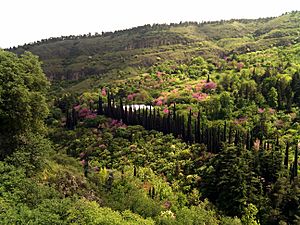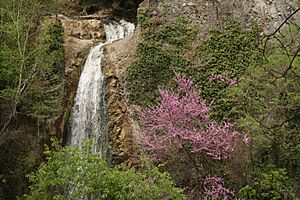National Botanical Garden of Georgia facts for kids
The National Botanical Garden of Georgia (which used to be called the Tbilisi Botanical Garden) is a special place in Tbilisi, the capital city of Georgia. It sits in the Tsavkisis-Tskali Gorge, at the bottom of the Sololaki Range hills. This huge garden covers 161 hectares (that's about 400 acres!) and has a collection of over 4,500 different types of plants.
This amazing garden has a history that goes back more than 300 years! A French traveler named Jean Chardin first wrote about it in 1671, calling them "royal gardens." These gardens might have started as early as 1625. They were sometimes known as "fortress gardens" or "Seidabad gardens." The gardens also show up on old maps of Tbilisi from 1735. After being damaged in a battle in 1795, the garden was brought back to life in the early 1800s. It officially became the Tiflis Botanical Garden in 1845.
Many famous scientists, like Yuri Voronov, have worked at the Garden since 1888. The Garden grew bigger between 1896 and 1904. From 1932 to 1958, more land was added. Some old graves, including that of the famous Azerbaijani writer Mirza Fatali Akhundov, are still there. The main entrance to the Garden is near the Narikala Fortress.
Contents
A Long History of Plants
People in Georgia have been bringing in, growing, and choosing plants from other countries for a very long time. Even old Greek myths talk about the famous garden of medicinal plants belonging to Medea. In the Georgian language, there are many words for a garden, showing how important they were for beauty and healing. Some words mean "Place Greens" or "Paradise."
Royal Gardens and Their Beginnings
Old maps of Tbilisi from the 1700s show that there were three small gardens in what is now the botanical garden. These gardens belonged to the kings. Historians say that Georgian kings grew a garden in Leghvtakhevi, right in front of their palace. A French traveler also wrote that the royal garden was looked after by Queen Mary, the wife of the last king of Kartli-Kakheti.
After Georgia joined Russia in 1801, the royal garden was renamed the "Tbilisi Treasury Garden."
Becoming a Scientific Center
On May 1, 1845, the royal garden officially became the "Tbilisi Botanical Garden." The Viceroy of the Caucasus himself looked after it. For almost 100 years, the Tbilisi Botanical Garden was the only science center for plants in the Caucasus region. During this time, a small greenhouse for woody plants was built. Walls were put up to hold the soil, and three levels (terraces) were created.
The garden also gave away young fruit trees, grapevines, and new kinds of vegetables for free. A system to water the plants was also set up.
Growing and Learning
Important garden designers and tree experts later led the garden. In the late 1800s and early 1900s, a gardening school opened there. People even called it the "Garden of the Gardener School." The garden was built in 12 steps. In 1872, materials for a greenhouse came from France, and a small, arched greenhouse was built in 1873.
By the end of 1875, the garden had 1238 different kinds of plants growing outdoors and in greenhouses. This included pineapples! There were also 134 types of roses. The first list of plants in the botanical garden was published. A museum was started, and a collection of dried plants from the Caucasus was begun. A library was also set up.
Important Scientists and Modern Growth
From 1899, Adolf Christian Rollov was in charge. During his time, the botanical garden became a big science place with proper labs and offices.
Many well-known Georgian scientists, like Niko Ketskhoveli and Levan Kanchaveli, worked and learned at the botanical garden. These experts helped the garden grow and develop throughout the 1900s.
New departments were started, like one for plant protection. They also began publishing scientific papers again. Collections of bright forest trees, Himalayan trees, and shrubs from the eastern Transcaucasus were grown. Labs for plant health, farming methods, and protecting nature were created. New buildings for labs and offices were also built. A new watering system was put in for the whole garden. In 1956, a beautiful artistic garden area called Parter was finished.
Under Mamma Loria's leadership, a museum of woody plants was opened. Special areas were created for rare and disappearing plants from Georgia, and a collection of lilacs was started.
In 2009, for the first time in the South Caucasus, a meeting of the International Council of Botanical Gardens (BGCI) was held in Tbilisi. This showed how important the garden was on a global scale.
In 2011, the National Botanical Garden of Georgia received money from the Royal Botanical Garden in the UK. This money helped to fix up and expand the building for plant conservation. Old historical parts of the garden were also restored. The main bridge was fixed, along with two towers, a part of the Narikala fortress fence, and the Tamara Bridge. The old building at the main entrance was also renovated.
The Garden Today
Today, the botanical garden covers 97 hectares. About 40 hectares are used for plants, roads, and buildings. The other 58 hectares are natural wild areas. The garden has about 800 types of native plants. The collection of plants in the botanical garden has about 3500 different kinds, including subspecies and special varieties.
The National Botanical Garden of Georgia has 6 science and research departments. These include departments for rare and medicinal plants, woody plant introduction, public relations, landscape design, plant conservation, and plant and soil protection. The garden also has a tropical plant greenhouse and a plant nursery.
Gallery
See also
 In Spanish: Jardín Botánico Central de la Academia de Ciencias de Georgia para niños
In Spanish: Jardín Botánico Central de la Academia de Ciencias de Georgia para niños






